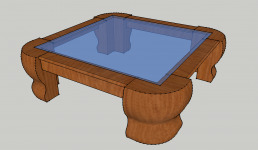humantorch
Member
- Joined
- Nov 20, 2013
- Messages
- 47
Hey all,
So I have a client that is looking for a coffee table with some massive legs. This is normally not my cup 'o tea but I'm very strapped for dollars and this client has a lot of them. (I do much more modern stuff)
That said attached is a picture. I really have no idea how to go about gluing up the pieces so that I don't run into issue with wood movement later on down the road.
Does anyone have any suggestions? They are roughly 14" x 14" x 18" and I'm thinking walnut or oak. I may try and guide the client toward NOT having the "L" in the inside of the legs and having just large rectangular posts instead....Just for ease of build.
My thought was to glue up a bunch of 8/4 stock and then square it all up and hand carve the curves.
Any and all input on this would be greatly appreciated.
Thanks!!!
[attachimg=1]
So I have a client that is looking for a coffee table with some massive legs. This is normally not my cup 'o tea but I'm very strapped for dollars and this client has a lot of them. (I do much more modern stuff)
That said attached is a picture. I really have no idea how to go about gluing up the pieces so that I don't run into issue with wood movement later on down the road.
Does anyone have any suggestions? They are roughly 14" x 14" x 18" and I'm thinking walnut or oak. I may try and guide the client toward NOT having the "L" in the inside of the legs and having just large rectangular posts instead....Just for ease of build.
My thought was to glue up a bunch of 8/4 stock and then square it all up and hand carve the curves.
Any and all input on this would be greatly appreciated.
Thanks!!!
[attachimg=1]

